Landslide Susceptibility Assessment and Future Prediction with Land Use Change and Urbanization towards Sustainable Development: The Case of the Li River Valley in Yongding, China
Abstract
1. Introduction
2. Materials and Methods
2.1. Study Area
2.2. Data Source
2.3. Methods
2.3.1. Predisposing Factor Selection and Rating Criteria
2.3.2. Multicollinearity Analysis
2.3.3. AHP-CI Model
2.3.4. LR Model
2.3.5. Model Validation
2.3.6. CA–Markov Model
- Convert the existing land use data and driving factor data into ASCII format and import the ASCII data into IDRISI Selva software.
- Reclass the land use data.
- Use the Markov function in the software to make the Markov transition area file on land use and set the proportion error as 0.1 (10%).
- Use the Reclass function to make a binary map of every land use type in the prediction base year.
- Use a binary map to collect transition suitability images for the driving factors and every land use type with the Logistic function in the software.
- Predict the future land use data in ASCII format by using the base year land use data, the transition suitability image collection, and the Markov transition area file, with the CA-Markov function in the software. And set the number of iterations to 5/10/20 times.
- Convert ASCII future land use data into vector data.
3. Results
3.1. Results of Multicollinearity Analysis
3.2. Outcomes of the AHP-CI Model and the LR Model
3.3. Model Validation and Performance Comparsion
3.4. Future Prediction of LSA Using the CA–Markov Model
4. Discussion
4.1. AHP-CI and LR Model Result Interpretation
4.2. Model Performance Comparsion and Future Prediction of LSA by CA-Markov Model
4.3. Landslide Management and Sustainable Development
4.4. Limitations and Future Research
5. Conclusions
Author Contributions
Funding
Institutional Review Board Statement
Informed Consent Statement
Data Availability Statement
Conflicts of Interest
References
- Rohan, T.; Shelef, E.; Mirus, B.; Coleman, T. Prolonged influence of urbanization on landslide susceptibility. Landslides 2023, 20, 1433–1447. [Google Scholar] [CrossRef]
- Thein, K.S.M.; Nagai, M.; Nakamura, T.; Phienwej, N.; Pal, I. Assessment of the Impacts of Urbanization on Landslide Susceptibility in Hakha City, A Mountainous Region of Western Myanmar. Land 2023, 12, 1036. [Google Scholar] [CrossRef]
- Malka, A. GIS-Based Landslide Susceptibility Modelling in Urbanized Areas: A Case Study of the Tri-City Area of Poland. GeoHazards 2022, 3, 508–528. [Google Scholar] [CrossRef]
- Ye, B.; Qiu, H.; Tang, B.; Liu, Y.; Liu, Z.; Jiang, X.; Yang, D.; Ullah, M.; Zhu, Y.; Kamp, U. Creep deformation monitoring of landslides in a reservoir area. J. Hydrol. 2024, 632, 130905. [Google Scholar] [CrossRef]
- Guzzetti, F.; Reichenbach, P.; Ardizzone, F.; Cardinali, M.; Galli, M. Estimating the quality of landslide susceptibility models. Geomorphology 2006, 81, 166–184. [Google Scholar] [CrossRef]
- Reichenbach, P.; Rossi, M.; Malamud, B.D.; Mihir, M.; Guzzetti, F. A review of statistically-based landslide susceptibility models. Earth-Sci. Rev. 2018, 180, 60–91. [Google Scholar] [CrossRef]
- Huang, F.; Cao, Z.; Guo, J.; Jiang, S.-H.; Li, S.; Guo, Z. Comparisons of heuristic, general statistical and machine learning models for landslide susceptibility prediction and mapping. Catena 2020, 191, 104580. [Google Scholar] [CrossRef]
- Pellicani, R.; Frattini, P.; Spilotro, G. Landslide susceptibility assessment in Apulian Southern Apennine: Heuristic vs. statistical methods. Environ. Earth Sci. 2014, 72, 1097–1108. [Google Scholar] [CrossRef]
- Cervi, F.; Berti, M.; Borgatti, L.; Ronchetti, F.; Manenti, F.; Corsini, A. Comparing predictive capability of statistical and deterministic methods for landslide susceptibility mapping: A case study in the northern Apennines (Reggio Emilia Province, Italy). Landslides 2010, 7, 433–444. [Google Scholar] [CrossRef]
- Yalcin, A. GIS-based landslide susceptibility mapping using analytical hierarchy process and bivariate statistics in Ardesen (Turkey): Comparisons of results and confirmations. Catena 2008, 72, 1–12. [Google Scholar] [CrossRef]
- Akgun, A.; Dag, S.; Bulut, F. Landslide susceptibility mapping for a landslide-prone area (Findikli, NE of Turkey) by likelihood-frequency ratio and weighted linear combination models. Environ. Geol. 2008, 54, 1127–1143. [Google Scholar] [CrossRef]
- Stanley, T.; Kirschbaum, D.B. A heuristic approach to global landslide susceptibility mapping. Nat. Hazards 2017, 87, 145–164. [Google Scholar] [CrossRef] [PubMed]
- Du, J.; Glade, T.; Woldai, T.; Chai, B.; Zeng, B. Landslide susceptibility assessment based on an incomplete landslide inventory in the Jilong Valley, Tibet, Chinese Himalayas. Eng. Geol. 2020, 270, 105572. [Google Scholar] [CrossRef]
- De Vita, P.; Napolitano, E.; Godt, J.; Baum, R. Deterministic estimation of hydrological thresholds for shallow landslide initiation and slope stability models: Case study from the Somma-Vesuvius area of southern Italy. Landslides 2013, 10, 713–728. [Google Scholar] [CrossRef]
- Jelínek, R.; Wagner, P. Landslide hazard zonation by deterministic analysis (Veľká Čausa landslide area, Slovakia). Landslides 2007, 4, 339–350. [Google Scholar] [CrossRef]
- Ciurleo, M.; Cascini, L.; Calvello, M. A comparison of statistical and deterministic methods for shallow landslide susceptibility zoning in clayey soils. Eng. Geol. 2017, 223, 71–81. [Google Scholar] [CrossRef]
- Pradhan, A.M.S.; Oh, J.-R.; Jung, M.-S.; Kim, Y.-T. Predictive capability of deterministic and statistical models in weathered granite soil watershed. In Landslide Science for a Safer Geoenvironment; Volume 2: Methods of Landslide Studies; Springer: Berlin/Heidelberg, Germany, 2014; pp. 507–512. [Google Scholar]
- Lin, W.; Yin, K.; Wang, N.; Xu, Y.; Guo, Z.; Li, Y. Landslide hazard assessment of rainfall-induced landslide based on the CF-SINMAP model: A case study from Wuling Mountain in Hunan Province, China. Nat. Hazards 2021, 106, 679–700. [Google Scholar] [CrossRef]
- Guo, Z.; Tian, B.; He, J.; Xu, C.; Zeng, T.; Zhu, Y. Hazard assessment for regional typhoon-triggered landslides by using physically-based model–a case study from southeastern China. Georisk Assess. Manag. Risk Eng. Syst. Geohazards 2023, 17, 740–754. [Google Scholar] [CrossRef]
- Jia, N.; Mitani, Y.; Xie, M.; Tong, J.; Yang, Z. GIS deterministic model-based 3D large-scale artificial slope stability analysis along a highway using a new slope unit division method. Nat. Hazards 2015, 76, 873–890. [Google Scholar] [CrossRef]
- Xiong, H.; Ma, C.; Li, M.; Tan, J.; Wang, Y. Landslide susceptibility prediction considering land use change and human activity: A case study under rapid urban expansion and afforestation in China. Sci. Total Environ. 2023, 866, 161430. [Google Scholar] [CrossRef]
- Liu, Y.; Qiu, H.; Kamp, U.; Wang, N.; Wang, J.; Huang, C.; Tang, B. Higher temperature sensitivity of retrogressive thaw slump activity in the Arctic compared to the Third Pole. Sci. Total Environ. 2024, 914, 170007. [Google Scholar] [CrossRef] [PubMed]
- Lee, S. Application of logistic regression model and its validation for landslide susceptibility mapping using GIS and remote sensing data. Int. J. Remote Sens. 2005, 26, 1477–1491. [Google Scholar] [CrossRef]
- Park, S.; Choi, C.; Kim, B.; Kim, J. Landslide susceptibility mapping using frequency ratio, analytic hierarchy process, logistic regression, and artificial neural network methods at the Inje area, Korea. Environ. Earth Sci. 2013, 68, 1443–1464. [Google Scholar] [CrossRef]
- Kayastha, P.; Dhital, M.R.; De Smedt, F. Landslide susceptibility mapping using the weight of evidence method in the Tinau watershed, Nepal. Nat. Hazards 2012, 63, 479–498. [Google Scholar] [CrossRef]
- Shahri, A.A.; Spross, J.; Johansson, F.; Larsson, S. Landslide susceptibility hazard map in southwest Sweden using artificial neural network. Catena 2019, 183, 104225. [Google Scholar] [CrossRef]
- Wang, Y.; Fang, Z.; Wang, M.; Peng, L.; Hong, H. Comparative study of landslide susceptibility mapping with different recurrent neural networks. Comput. Geosci. 2020, 138, 104445. [Google Scholar] [CrossRef]
- Remondo, J.; Bonachea, J.; Cendrero, A. A statistical approach to landslide risk modelling at basin scale: From landslide susceptibility to quantitative risk assessment. Landslides 2005, 2, 321–328. [Google Scholar] [CrossRef]
- Pacheco Quevedo, R.; Velastegui-Montoya, A.; Montalván-Burbano, N.; Morante-Carballo, F.; Korup, O.; Daleles Rennó, C. Land use and land cover as a conditioning factor in landslide susceptibility: A literature review. Landslides 2023, 20, 967–982. [Google Scholar] [CrossRef]
- Shu, H.; Hürlimann, M.; Molowny-Horas, R.; González, M.; Pinyol, J.; Abancó, C.; Ma, J. Relation between land cover and landslide susceptibility in Val d’Aran, Pyrenees (Spain): Historical aspects, present situation and forward prediction. Sci. Total Environ. 2019, 693, 133557. [Google Scholar] [CrossRef]
- Gariano, S.L.; Guzzetti, F. Landslides in a changing climate. Earth-Sci. Rev. 2016, 162, 227–252. [Google Scholar] [CrossRef]
- Baioni, D. Human activity and damaging landslides and floods on Madeira Island. Nat. Hazards Earth Syst. Sci. 2011, 11, 3035–3046. [Google Scholar] [CrossRef]
- Zhou, N.-Q.; Zhao, S. Urbanization process and induced environmental geological hazards in China. Nat. Hazards 2013, 67, 797–810. [Google Scholar] [CrossRef]
- Mitsuda, Y.; Ito, S. A review of spatial-explicit factors determining spatial distribution of land use/land-use change. Landsc. Ecol. Eng. 2011, 7, 117–125. [Google Scholar] [CrossRef]
- Rowcroft, P. Frontiers of change: The reasons behind land-use change in the Mekong Basin. AMBIO J. Hum. Environ. 2008, 37, 213–218. [Google Scholar] [CrossRef]
- Pisano, L.; Zumpano, V.; Malek, Ž.; Rosskopf, C.M.; Parise, M. Variations in the susceptibility to landslides, as a consequence of land cover changes: A look to the past, and another towards the future. Sci. Total Environ. 2017, 601, 1147–1159. [Google Scholar] [CrossRef]
- Meneses, B.M.; Pereira, S.; Reis, E. Effects of different land use and land cover data on the landslide susceptibility zonation of road networks. Nat. Hazards Earth Syst. Sci. 2019, 19, 471–487. [Google Scholar] [CrossRef]
- Pham, Q.B.; Chandra Pal, S.; Chakrabortty, R.; Saha, A.; Janizadeh, S.; Ahmadi, K.; Khedher, K.M.; Anh, D.T.; Tiefenbacher, J.P.; Bannari, A. Predicting landslide susceptibility based on decision tree machine learning models under climate and land use changes. Geocarto Int. 2022, 37, 7881–7907. [Google Scholar] [CrossRef]
- Hürlimann, M.; Guo, Z.; Puig-Polo, C.; Medina, V. Impacts of future climate and land cover changes on landslide susceptibility: Regional scale modelling in the Val d’Aran region (Pyrenees, Spain). Landslides 2022, 19, 99–118. [Google Scholar] [CrossRef]
- Jurchescu, M.; Kucsicsa, G.; Micu, M.; Bălteanu, D.; Sima, M.; Popovici, E.-A. Implications of future land-use/cover pattern change on landslide susceptibility at a national level: A scenario-based analysis in Romania. Catena 2023, 231, 107330. [Google Scholar] [CrossRef]
- Chowdhuri, I.; Pal, S.C.; Chakrabortty, R.; Malik, S.; Das, B.; Roy, P.; Sen, K. Spatial prediction of landslide susceptibility using projected storm rainfall and land use in Himalayan region. Bull. Eng. Geol. Environ. 2021, 80, 5237–5258. [Google Scholar] [CrossRef]
- Nanehkaran, Y.A.; Chen, B.; Cemiloglu, A.; Chen, J.; Anwar, S.; Azarafza, M.; Derakhshani, R. Riverside landslide susceptibility overview: Leveraging artificial neural networks and machine learning in accordance with the United Nations (UN) sustainable development goals. Water 2023, 15, 2707. [Google Scholar] [CrossRef]
- Yahman, N.K.; Sarkom, Y.; Ariff, N.R.M. Achieving SDGs 11: A Review on Neighbourhood Engagement in Local Authorities towards Disaster Risk Reduction of Highland Developments in Selangor; IOP Conference Series: Earth and Environmental Science; IOP Publishing: Bristol, UK, 2022; p. 012007. [Google Scholar]
- Tian, N.; Lan, H. The indispensable role of resilience in rational landslide risk management for social sustainability. Geogr. Sustain. 2023, 4, 70–83. [Google Scholar] [CrossRef]
- Bolla, A.; Paronuzzi, P. Geomechanical field survey to identify an unstable rock slope: The Passo della Morte case history (NE Italy). Rock Mech. Rock Eng. 2020, 53, 1521–1544. [Google Scholar] [CrossRef]
- Ma, C.; Yan, Z.; Huang, P.; Gao, L. Evaluation of landslide susceptibility based on the occurrence mechanism of landslide: A case study in Yuan’an county, China. Environ. Earth Sci. 2021, 80, 94. [Google Scholar] [CrossRef]
- Gomez, H.; Kavzoglu, T. Assessment of shallow landslide susceptibility using artificial neural networks in Jabonosa River Basin, Venezuela. Eng. Geol. 2005, 78, 11–27. [Google Scholar] [CrossRef]
- Tan, J.; Yang, C.; Wang, Y.; Xiong, H.; Ma, C. A hybrid model to overcome landslide inventory incompleteness issue for landslide susceptibility prediction. Geocarto Int. 2024, 39, 2322066. [Google Scholar] [CrossRef]
- Ercanoglu, M.; Gokceoglu, C. Assessment of landslide susceptibility for a landslide-prone area (north of Yenice, NW Turkey) by fuzzy approach. Environ. Geol. 2002, 41, 720–730. [Google Scholar]
- Segoni, S.; Pappafico, G.; Luti, T.; Catani, F. Landslide susceptibility assessment in complex geological settings: Sensitivity to geological information and insights on its parameterization. Landslides 2020, 17, 2443–2453. [Google Scholar] [CrossRef]
- Xie, Z.; Chen, G.; Meng, X.; Zhang, Y.; Qiao, L.; Tan, L. A comparative study of landslide susceptibility mapping using weight of evidence, logistic regression and support vector machine and evaluated by SBAS-InSAR monitoring: Zhouqu to Wudu segment in Bailong River Basin, China. Environ. Earth Sci. 2017, 76, 313. [Google Scholar] [CrossRef]
- Pourghasemi, H.R.; Teimoori Yansari, Z.; Panagos, P.; Pradhan, B. Analysis and evaluation of landslide susceptibility: A review on articles published during 2005–2016 (periods of 2005–2012 and 2013–2016). Arab. J. Geosci. 2018, 11, 193. [Google Scholar] [CrossRef]
- Pourghasemi, H.R.; Kornejady, A.; Kerle, N.; Shabani, F. Investigating the effects of different landslide positioning techniques, landslide partitioning approaches, and presence-absence balances on landslide susceptibility mapping. Catena 2020, 187, 104364. [Google Scholar] [CrossRef]
- Bui, D.T.; Lofman, O.; Revhaug, I.; Dick, O. Landslide susceptibility analysis in the Hoa Binh province of Vietnam using statistical index and logistic regression. Nat. Hazards 2011, 59, 1413–1444. [Google Scholar] [CrossRef]
- Raja, N.B.; Çiçek, I.; Türkoğlu, N.; Aydin, O.; Kawasaki, A. Landslide susceptibility mapping of the Sera River Basin using logistic regression model. Nat. Hazards 2017, 85, 1323–1346. [Google Scholar] [CrossRef]
- Chen, T.; Niu, R.; Jia, X. A comparison of information value and logistic regression models in landslide susceptibility mapping by using GIS. Environ. Earth Sci. 2016, 75, 867. [Google Scholar] [CrossRef]
- Saaty, T.L. Axiomatic foundation of the analytic hierarchy process. Manag. Sci. 1986, 32, 841–855. [Google Scholar] [CrossRef]
- Xiong, H.; Sun, Y.; Ren, X. Comprehensive assessment of water sensitive urban design practices based on multi-criteria decision analysis via a case study of the University of Melbourne, Australia. Water 2020, 12, 2885. [Google Scholar] [CrossRef]
- Li, M.; Guo, Y.; Luo, D.; Ma, C. A Hybrid Variable Weight Theory Approach of Hierarchical Analysis and Multi-Layer Perceptron for Landslide Susceptibility Evaluation: A Case Study in Luanchuan County, China. Sustainability 2023, 15, 1908. [Google Scholar] [CrossRef]
- Wang, Z.; Xiong, H.; Ma, C.; Zhang, F.; Li, X. Assessment of groundwater vulnerability by applying the improved DRASTIC model: A case in Guyuan City, Ningxia, China. Environ. Sci. Pollut. Res. 2023, 30, 59062–59075. [Google Scholar] [CrossRef]
- Wang, Z.; Xiong, H.; Zhang, F.; Qiu, Y.; Ma, C. Sustainable development assessment of ecological vulnerability in arid areas under the influence of multiple indicators. J. Clean. Prod. 2024, 436, 140629. [Google Scholar] [CrossRef]
- Bursac, Z.; Gauss, C.H.; Williams, D.K.; Hosmer, D.W. Purposeful selection of variables in logistic regression. Source Code Biol. Med. 2008, 3, 17. [Google Scholar] [CrossRef] [PubMed]
- Stoltzfus, J.C. Logistic regression: A brief primer. Acad. Emerg. Med. 2011, 18, 1099–1104. [Google Scholar] [CrossRef] [PubMed]
- Morrissey, E.R.; McElnay, J.C.; Scott, M.; McConnell, B.J. Influence of drugs, demographics and medical history on hospital readmission of elderly patients: A predictive model. Clin. Drug Investig. 2003, 23, 119–128. [Google Scholar] [CrossRef]
- Bendel, R.B.; Afifi, A.A. Comparison of stopping rules in forward “stepwise” regression. J. Am. Stat. Assoc. 1977, 72, 46–53. [Google Scholar]
- Sang, L.; Zhang, C.; Yang, J.; Zhu, D.; Yun, W. Simulation of land use spatial pattern of towns and villages based on CA–Markov model. Math. Comput. Model. 2011, 54, 938–943. [Google Scholar] [CrossRef]
- Wu, Y.; Ke, Y.; Chen, Z.; Liang, S.; Zhao, H.; Hong, H. Application of alternating decision tree with AdaBoost and bagging ensembles for landslide susceptibility mapping. Catena 2020, 187, 104396. [Google Scholar] [CrossRef]
- Daba, M.H.; You, S. Quantitatively assessing the future land-use/land-cover changes and their driving factors in the upper stream of the Awash River based on the CA–markov model and their implications for water resources management. Sustainability 2022, 14, 1538. [Google Scholar] [CrossRef]
- Hamad, R.; Balzter, H.; Kolo, K. Predicting land use/land cover changes using a CA-Markov model under two different scenarios. Sustainability 2018, 10, 3421. [Google Scholar] [CrossRef]
- Pourghasemi, H.R.; Pradhan, B.; Gokceoglu, C. Application of fuzzy logic and analytical hierarchy process (AHP) to landslide susceptibility mapping at Haraz watershed, Iran. Nat. Hazards 2012, 63, 965–996. [Google Scholar] [CrossRef]
- Kayastha, P.; Dhital, M.R.; De Smedt, F. Application of the analytical hierarchy process (AHP) for landslide susceptibility mapping: A case study from the Tinau watershed, west Nepal. Comput. Geosci. 2013, 52, 398–408. [Google Scholar] [CrossRef]
- Abedini, M.; Tulabi, S. Assessing LNRF, FR, and AHP models in landslide susceptibility mapping index: A comparative study of Nojian watershed in Lorestan province, Iran. Environ. Earth Sci. 2018, 77, 405. [Google Scholar] [CrossRef]
- Ercanoglu, M.; Kasmer, O.; Temiz, N. Adaptation and comparison of expert opinion to analytical hierarchy process for landslide susceptibility mapping. Bull. Eng. Geol. Environ. 2008, 67, 565–578. [Google Scholar] [CrossRef]
- Depicker, A.; Jacobs, L.; Mboga, N.; Smets, B.; Van Rompaey, A.; Lennert, M.; Wolff, E.; Kervyn, F.; Michellier, C.; Dewitte, O. Historical dynamics of landslide risk from population and forest-cover changes in the Kivu Rift. Nat. Sustain. 2021, 4, 965–974. [Google Scholar] [CrossRef]
- Shano, L.; Raghuvanshi, T.K.; Meten, M. Landslide susceptibility evaluation and hazard zonation techniques—A review. Geoenviron. Disasters 2020, 7, 18. [Google Scholar] [CrossRef]
- Rabby, Y.W.; Li, Y.; Abedin, J.; Sabrina, S. Impact of land use/land cover change on landslide susceptibility in Rangamati Municipality of Rangamati District, Bangladesh. ISPRS Int. J. Geo-Inf. 2022, 11, 89. [Google Scholar] [CrossRef]
- Pineda, M.; Viloria, J.; Martínez-Casasnovas, J.A. Landslides susceptibility change over time according to terrain conditions in a mountain area of the tropic region. Environ. Monit. Assess. 2016, 188, 255. [Google Scholar] [CrossRef] [PubMed]
- Chen, L.; Guo, Z.; Yin, K.; Shrestha, D.P.; Jin, S. The influence of land use and land cover change on landslide susceptibility: A case study in Zhushan Town, Xuan’en County (Hubei, China). Nat. Hazards Earth Syst. Sci. 2019, 19, 2207–2228. [Google Scholar] [CrossRef]
- Tyagi, A.; Tiwari, R.K.; James, N. Mapping the landslide susceptibility considering future land-use land-cover scenario. Landslides 2023, 20, 65–76. [Google Scholar] [CrossRef]
- Persichillo, M.G.; Bordoni, M.; Meisina, C. The role of land use changes in the distribution of shallow landslides. Sci. Total Environ. 2017, 574, 924–937. [Google Scholar] [CrossRef]
- Hák, T.; Janoušková, S.; Moldan, B. Sustainable Development Goals: A need for relevant indicators. Ecol. Indic. 2016, 60, 565–573. [Google Scholar] [CrossRef]
- Roodposhti, M.S.; Aryal, J.; Pradhan, B. A novel rule-based approach in mapping landslide susceptibility. Sensors 2019, 19, 2274. [Google Scholar] [CrossRef] [PubMed]
- Berger, A.; Ettlin, G.; Quincke, C.; Rodríguez-Bocca, P. Predicting the Normalized Difference Vegetation Index (NDVI) by training a crop growth model with historical data. Comput. Electron. Agric. 2019, 161, 305–311. [Google Scholar] [CrossRef]
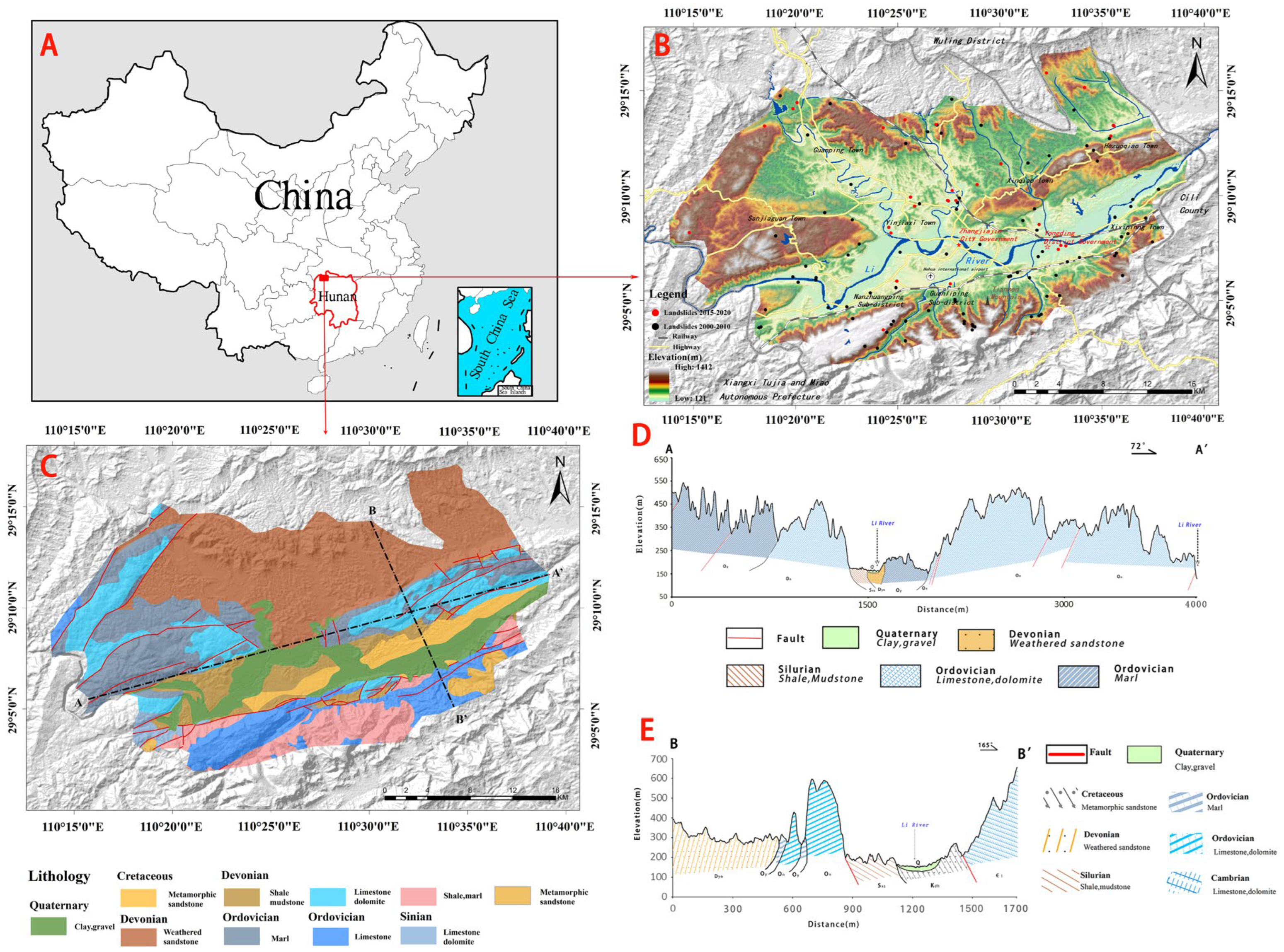
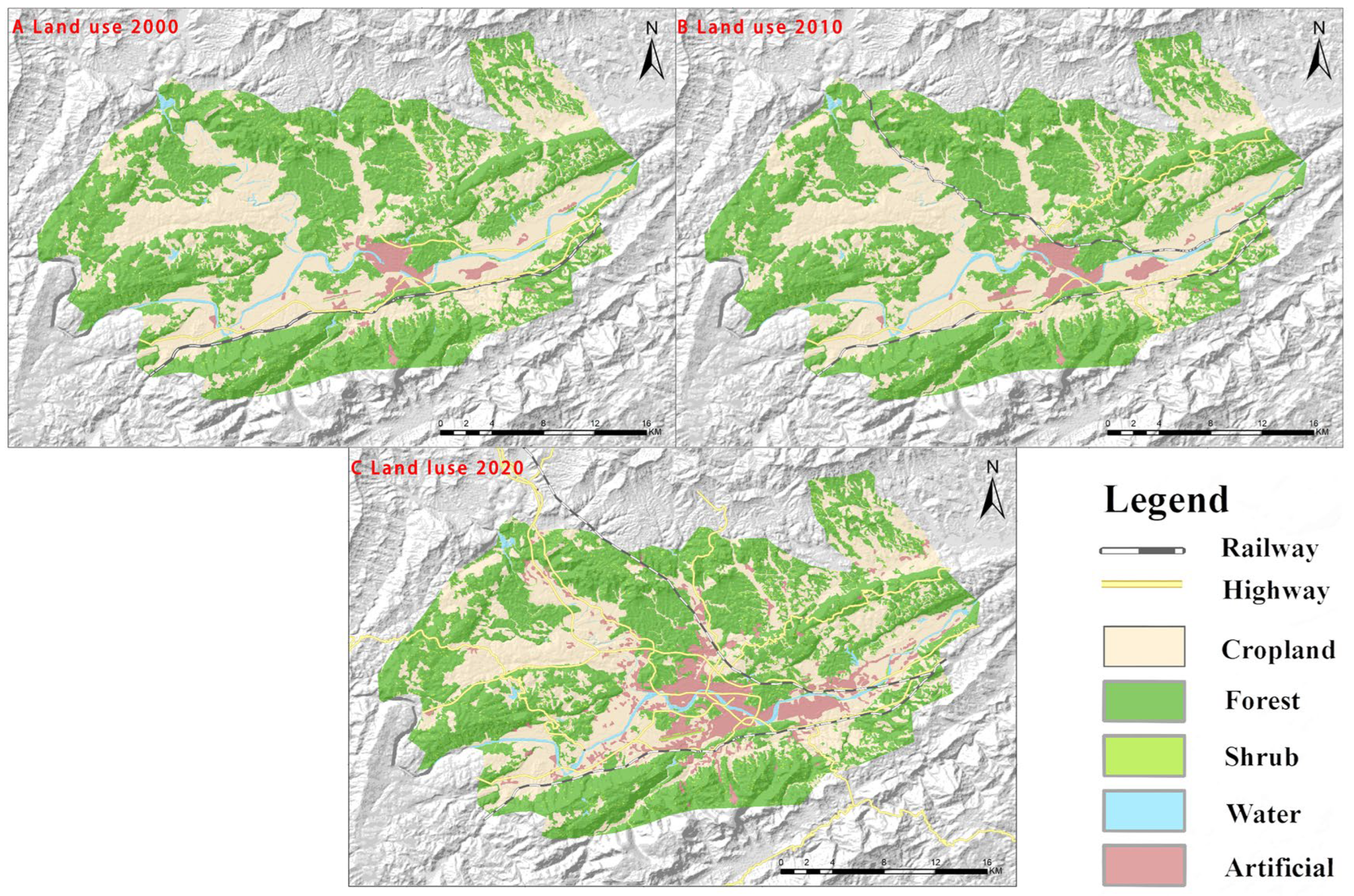
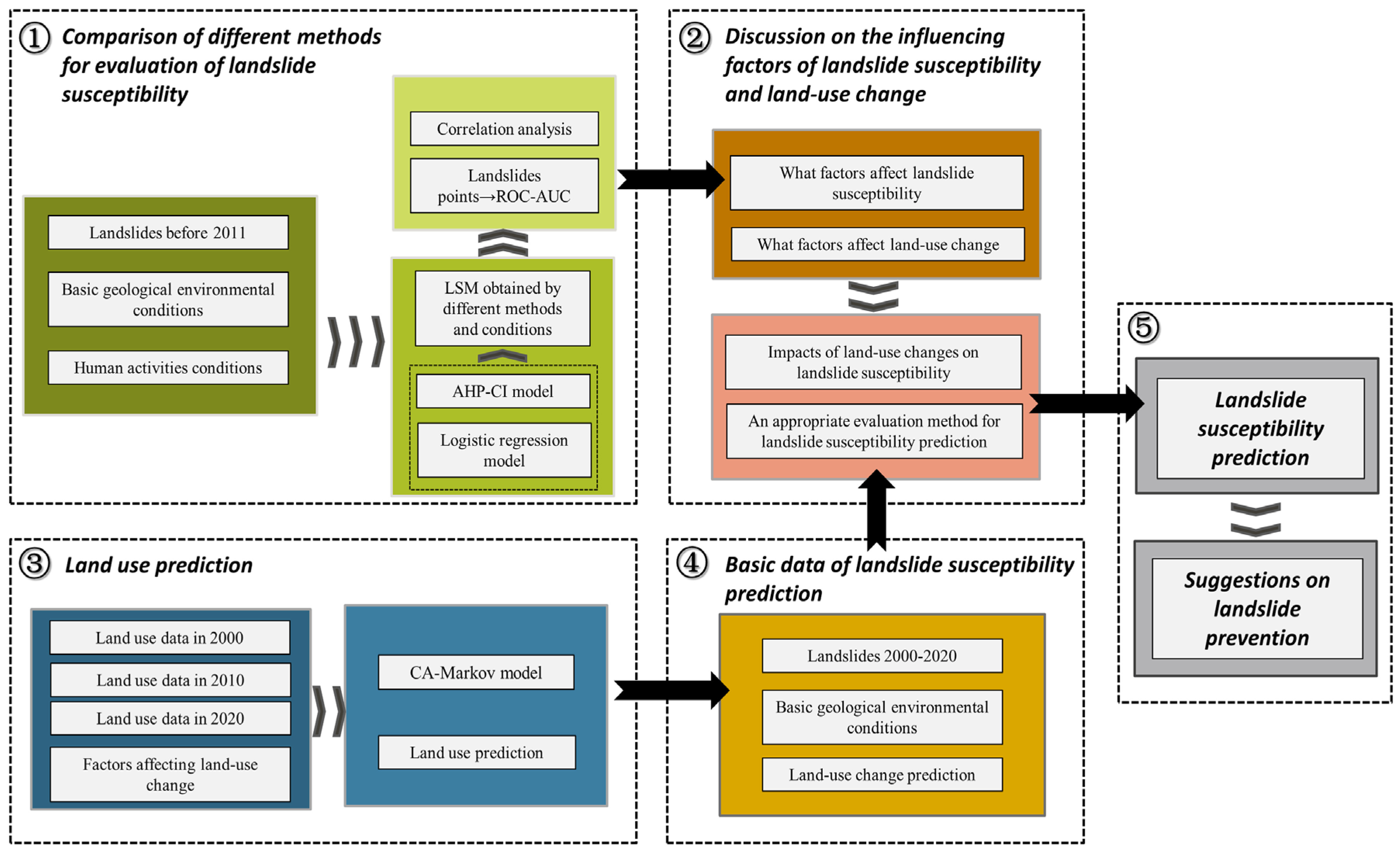
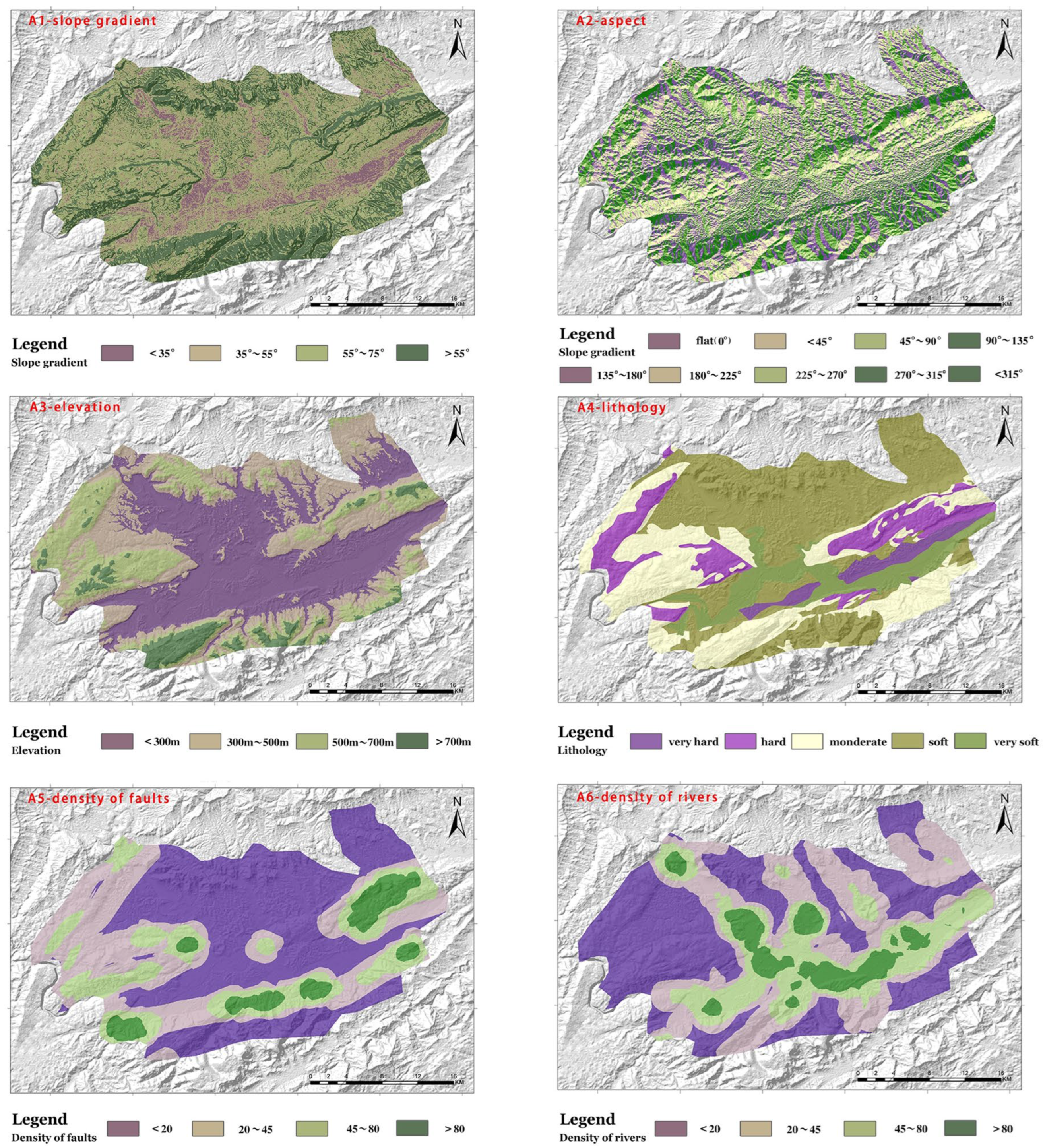




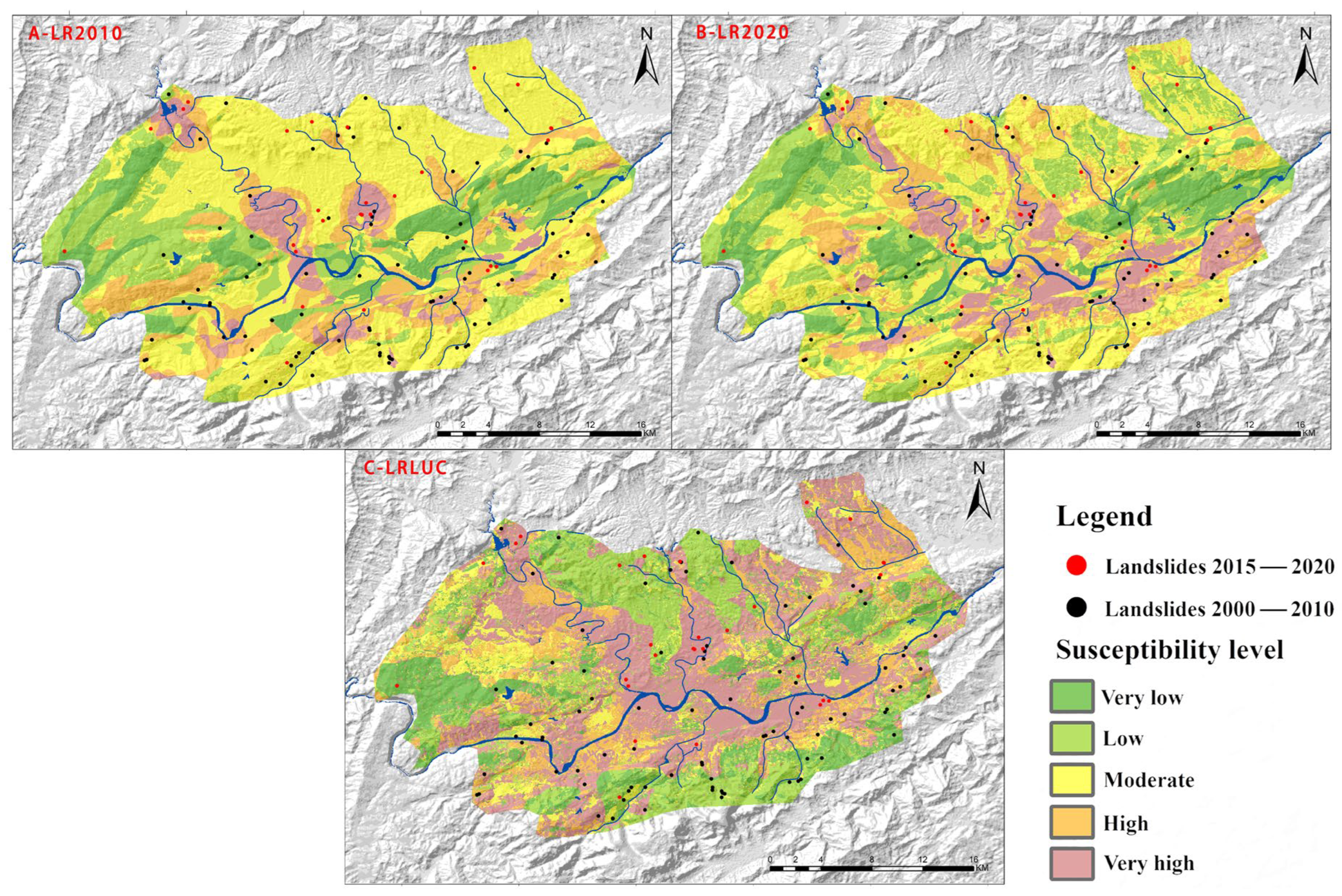
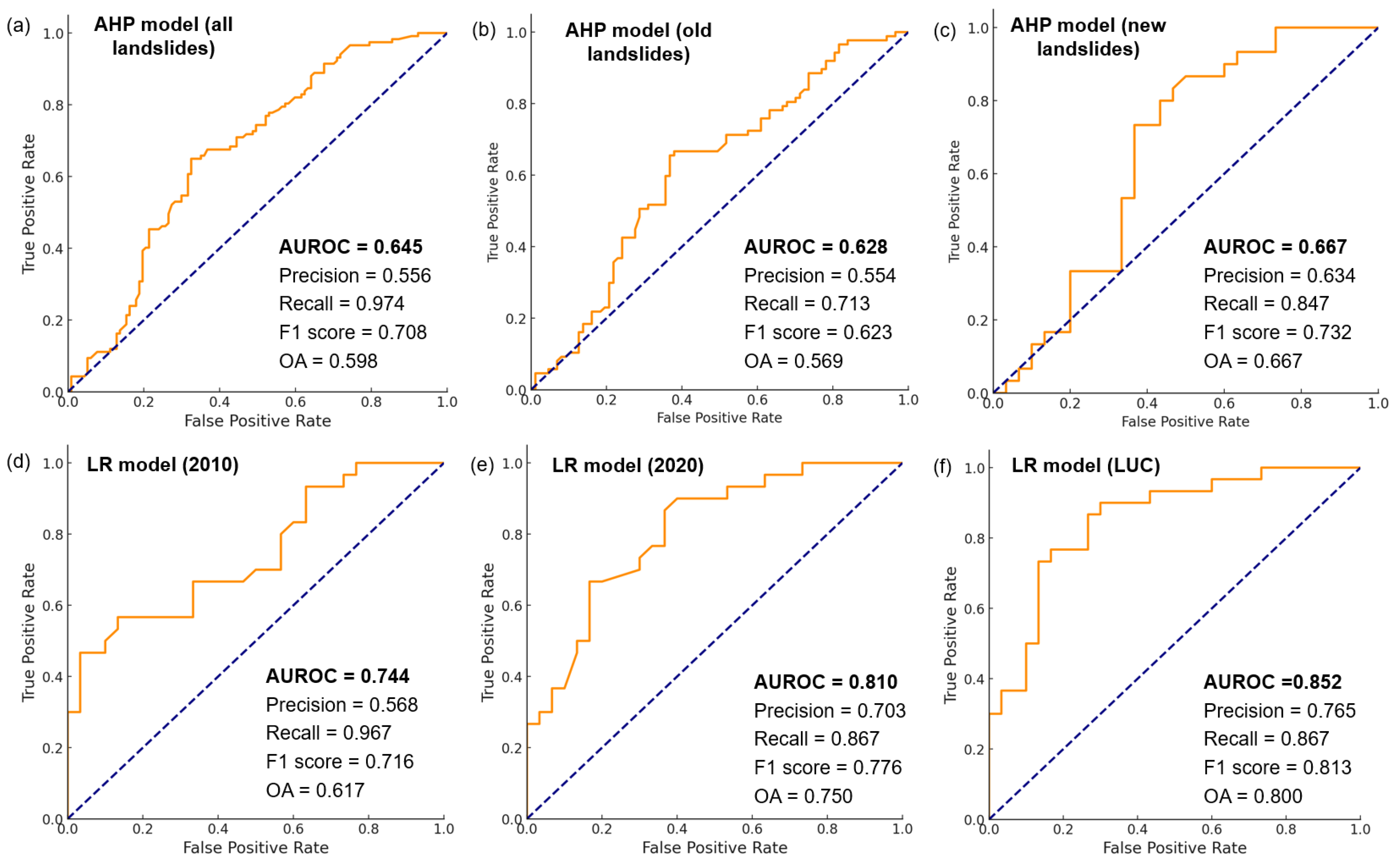


| Data Name | Data Layer | Source of Data | Scale |
|---|---|---|---|
| DEM | Elevation | Geospatial Data Cloud | 30 m |
| Slope | |||
| Aspect | |||
| Basic geologic map | Lithologic | Hunan Geological Environment Monitoring Station | 1:250,000 |
| Fault | |||
| River network | |||
| NDVI | NDVI | NASA (MOD13Q1) | 250 m |
| Landslides 2000~2010 | Landslides 2000~2010 | Hunan Geological Environment Monitoring Station | / |
| Landslides 2015~2020 | Landslides 2015~2020 | Zhangjiajie City and Hunan Provincial People’s Government | / |
| Road network | Traffic conditions | Baidu Map | 1:100,000 |
| Land use | Land use | GlobeLand30 | 30 m |
| Predisposing Factors | Level | Selected Reasons | Score |
|---|---|---|---|
| Slope gradient (A1) | <35° | The LS increases with slope steepness due to the corresponding rise in the rock mass sliding force and stress concentration at the slope toes, enhancing instability risk [45,46]. | 1 (0.10) |
| 35~55° | 2 (0.20) | ||
| 55~70° | 3 (0.30) | ||
| >70° | 4 (0.40) | ||
| Aspect (A2) | flat | Aspect influences LS by affecting terrain’s moisture, weathering, and vegetation through its role in directing precipitation, wind, and solar radiation, leading to varying conditions that can either stabilize or weaken slopes [47,48]. | 1 (0.04) |
| <45(°) | 2 (0.07) | ||
| 45~90(°) | 3 (0.11) | ||
| 90~135(°) | 4 (0.15) | ||
| 135~180(°) | 5 (0.19) | ||
| 180~225(°) | 5 (0.19) | ||
| 225~270(°) | 3 (0.11) | ||
| 270~315(°) | 2 (0.07) | ||
| >315(°) | 2 (0.07) | ||
| Elevation (A3) | <300 m | Elevation indirectly influences landslide occurrence by altering precipitation, sunlight exposure, vegetation types, human activities, and soil characteristics across different heights [48,49]. | 3 (0.30) |
| 300~500 m | 4 (0.40) | ||
| 500~700 m | 2 (0.20) | ||
| >700 m | 1 (0.10) | ||
| Lithology (A4) | very soft | Slope stability is greatly affected by lithology because uniform, hard rock slopes are stable, while mixed soft–hard rock slopes are prone to landslides, especially in areas with weakly cemented, easily weathered Carboniferous sandstone [50]. | 5 (0.33) |
| soft | 4 (0.27) | ||
| moderate | 3 (0.20) | ||
| hard | 2 (0.13) | ||
| very hard | 1 (0.07) | ||
| Density of faults (A5) | <20 | Faults’ presence can induce the formation of fractures within the surrounding rock mass, thereby facilitating the development of potential slip surfaces that compromise slope stability [51]. | 1 (0.10) |
| 20~45 | 2 (0.20) | ||
| 45~80 | 3 (0.30) | ||
| >80 | 4 (0.40) | ||
| Density of rivers (A6) | <25 | Rivers erode slope bases and elevate nearby groundwater levels, thereby increasing slope mass and sliding forces while reducing resistance, ultimately heightening LS [52]. | 1 (0.10) |
| 25~70 | 2 (0.20) | ||
| 70~130 | 3 (0.30) | ||
| >130 | 4 (0.40) | ||
| Vegetation cover conditions (A7) | <0.4 | Vegetation roots enhance soil stability and mitigate water erosion on slopes; thus, increased vegetation coverage, as indicated by higher NDVI values, is correlated with reduced LS [53]. | 4 (0.40) |
| 0.4~0.6 | 3 (0.30) | ||
| 0.6~0.8 | 2 (0.20) | ||
| >0.8 | 1 (0.10) |
| Intensity of Importance | Definition |
|---|---|
| 1 | Equal importance |
| 2 | Weak |
| 3 | Moderate importance |
| 4 | Moderate plus |
| 5 | Strong importance |
| 6 | Strong plus |
| 7 | Very strong or demonstrated importance |
| 8 | Very, very strong |
| 9 | Extreme importance |
| Predisposing Factors | VIF |
|---|---|
| Slope gradient | 2.129 |
| Aspect | 1.169 |
| Elevation | 1.131 |
| Lithology | 1.360 |
| Density of faults | 1.864 |
| Density of rivers | 1.463 |
| Vegetation cover conditions | 3.441 |
| Land use conditions | 1.823 |
| Traffic condition changes | 4.053 |
| Vegetation condition changes | 3.142 |
| Predisposing Factors | A1 | A2 | A3 | A4 | A5 | A6 | A7 | Weight |
|---|---|---|---|---|---|---|---|---|
| A1 | 1 | 7 | 5 | 1 | 4 | 5 | 5 | 0.3281 |
| A2 | 1 | 1/2 | 1/7 | 1/3 | 1/3 | 1/2 | 0.0351 | |
| A3 | 1 | 1/5 | 1/2 | 1 | 1 | 0.0646 | ||
| A4 | 1 | 4 | 5 | 5 | 0.3281 | |||
| A5 | 1 | 2 | 3 | 0.1148 | ||||
| A6 | 1 | 1 | 0.0684 | |||||
| A7 | 1 | 0.0609 | ||||||
| ; ; | ||||||||
| 2010 | 2020 | 2000~2010 (LUC) | ||||||
|---|---|---|---|---|---|---|---|---|
| Predisposing Factors | Level | RC | Sig. | RC | Sig. | Level | RC | Sig. |
| Intercept | / | −4.446 | 0.000 | −3.914 | 0.000 | / | −1.407 | 0.036 |
| Slope gradient (A1) | / | / | / | / | / | / | / | / |
| Aspect (A2) | / | / | / | / | / | / | / | / |
| Elevation (A3) | / | / | / | / | / | / | / | / |
| Lithology (A4) | Very hard | / | / | / | / | Very hard | / | / |
| Hard | 0.551 | 0.108 | −0.061 | 0.064 | Hard | −0.884 | 0.009 | |
| Moderate | 2.143 | 0.000 | 1.482 | 0.000 | Moderate | 1.173 | 0.000 | |
| Soft | 2.171 | 0.000 | 1.406 | 0.000 | Soft | 1.331 | 0.000 | |
| Very soft | 1.485 | 0.000 | 1.186 | 0.000 | Very soft | 0.749 | 0.007 | |
| Density of faults (A5) | <20 | / | 0.000 | / | 0.000 | <20 | / | / |
| 20~45 | −0.375 | 0.021 | −0.749 | 0.000 | 20~45 | −0.352 | 0.037 | |
| 45~80 | 0.612 | 0.004 | 0.075 | 0.041 | 45~80 | 0.471 | 0.022 | |
| >80 | −0.140 | 0.021 | −0.637 | 0.008 | >80 | −0.639 | 0.005 | |
| Density of rivers (A6) | <25 | / | 0.000 | / | 0.000 | <25 | / | 0.000 |
| 25~70 | 0.226 | 0.157 | 0.169 | 0.304 | 25~70 | 0.136 | 0.024 | |
| 70~130 | 1.075 | 0.000 | 0.496 | 0.021 | 70~130 | 0.936 | 0.000 | |
| >130 | 2.203 | 0.000 | 1.598 | 0.000 | >130 | 3.557 | 0.000 | |
| Vegetation cover conditions (A7) | <0.4 | / | 0.000 | / | 0.000 | ΔNDVI < −0.05 | / | 0.000 |
| 0.4~0.6 | / | 0.000 | / | 0.000 | −0.05 < ΔNDVI < 0.05 | −0.328 | 0.015 | |
| 0.6~0.8 | 2.045 | 0.000 | 1.823 | 0.000 | ΔNDVI > 0.05 | −3.513 | 0.000 | |
| >0.8 | 2.167 | 0.000 | 2.296 | 0.000 | ||||
| Land use conditions (B1) | Forest | / | 0.000 | / | 0.000 | Forest | / | / |
| Shrubland | 0.384 | 0.139 | 0.697 | 0.041 | Old shrubland | 0.282 | 0.028 | |
| Water | 0.981 | 0.040 | 0.648 | 0.01 | New shrubland | 0.499 | 0.033 | |
| Cropland | 0.225 | 0.111 | 0.65 | 0.000 | Water | −3.06 | 0.007 | |
| Artificial | 1.904 | 0.000 | 1.682 | 0.002 | Old cropland | 0.727 | 0.033 | |
| New cropland | 2.936 | 0.000 | ||||||
| Artificial | 4.062 | 0.000 | ||||||
| Traffic conditions (B2) | <0.2 | / | / | / | / | Δdensity < 0.1 | / | / |
| 0.2~0.4 | / | / | 0.534 | 0.002 | 0.1 < Δdensity < 0.3 | / | / | |
| 0.4~0.6 | / | / | 0.346 | 0.082 | 0.3 < Δdensity < 0.5 | / | / | |
| 0.6~0.8 | / | / | 1.507 | 0.000 | 0.5 < Δdensity < 0.7 | / | / | |
| >0.8 | / | / | 2.02 | 0.000 | Δdensity > 0.7 | / | / |
| Model | AUROC | Lower Bound | Upper Bound |
|---|---|---|---|
| AHP-CI model (all landslides) | 0.645 | 0.573 | 0.718 |
| AHP-CI model (old landslides) | 0.628 | 0.541 | 0.705 |
| AHP-CI model (new landslides) | 0.667 | 0.523 | 0.781 |
| LR model (2010) | 0.744 | 0.623 | 0.861 |
| LR model (2020) | 0.810 | 0.695 | 0.904 |
| LR model (LUC) | 0.852 | 0.743 | 0.938 |
| No. | Goals | Interpretation for Landslide Mitigation |
|---|---|---|
| SDG1 | No Poverty | Goal 1 impacts landslide mitigation by empowering communities through enhanced resilience and access to resources, enabling more effective land use strategies, safer housing, and early warning systems in areas at risk. |
| SDG11 | Sustainable Cities and Communities | Goal 11 highlights the link between sustainable urban development and landslide risk reduction, advocating for enhanced urban planning and infrastructure to safeguard communities in landslide-prone areas. |
| SDG13 | Climate Action | Goal 13 mitigates landslide risks by addressing climate-induced changes, such as altered rainfall patterns and weather extremes, that influence landslide occurrences. |
| SDG15 | Life on Land | Goal 15 enhances resilience to landslides through sustainable land management, the conservation of forests, and the preservation of natural landscapes, thereby stabilizing slopes and promoting ecosystem health. |
Disclaimer/Publisher’s Note: The statements, opinions and data contained in all publications are solely those of the individual author(s) and contributor(s) and not of MDPI and/or the editor(s). MDPI and/or the editor(s) disclaim responsibility for any injury to people or property resulting from any ideas, methods, instructions or products referred to in the content. |
© 2024 by the authors. Licensee MDPI, Basel, Switzerland. This article is an open access article distributed under the terms and conditions of the Creative Commons Attribution (CC BY) license (https://creativecommons.org/licenses/by/4.0/).
Share and Cite
Yang, C.; Wang, J.; Li, S.; Xiong, R.; Li, X.; Gao, L.; Guo, X.; Ma, C.; Xiong, H.; Qiu, Y. Landslide Susceptibility Assessment and Future Prediction with Land Use Change and Urbanization towards Sustainable Development: The Case of the Li River Valley in Yongding, China. Sustainability 2024, 16, 4416. https://doi.org/10.3390/su16114416
Yang C, Wang J, Li S, Xiong R, Li X, Gao L, Guo X, Ma C, Xiong H, Qiu Y. Landslide Susceptibility Assessment and Future Prediction with Land Use Change and Urbanization towards Sustainable Development: The Case of the Li River Valley in Yongding, China. Sustainability. 2024; 16(11):4416. https://doi.org/10.3390/su16114416
Chicago/Turabian StyleYang, Chi, Jinghan Wang, Shuyi Li, Ruihan Xiong, Xiaobo Li, Lin Gao, Xu Guo, Chuanming Ma, Hanxiang Xiong, and Yang Qiu. 2024. "Landslide Susceptibility Assessment and Future Prediction with Land Use Change and Urbanization towards Sustainable Development: The Case of the Li River Valley in Yongding, China" Sustainability 16, no. 11: 4416. https://doi.org/10.3390/su16114416
APA StyleYang, C., Wang, J., Li, S., Xiong, R., Li, X., Gao, L., Guo, X., Ma, C., Xiong, H., & Qiu, Y. (2024). Landslide Susceptibility Assessment and Future Prediction with Land Use Change and Urbanization towards Sustainable Development: The Case of the Li River Valley in Yongding, China. Sustainability, 16(11), 4416. https://doi.org/10.3390/su16114416







